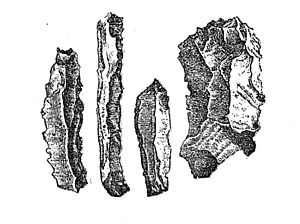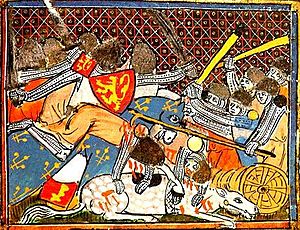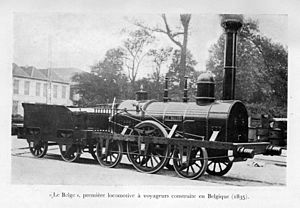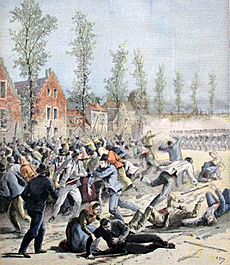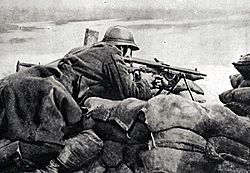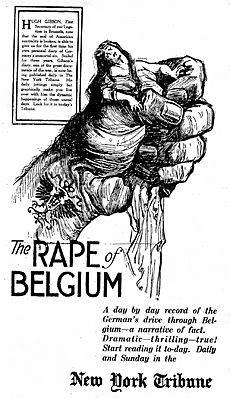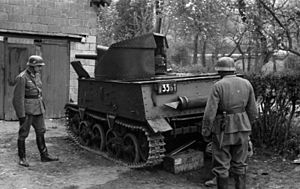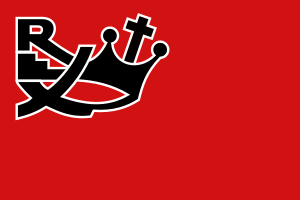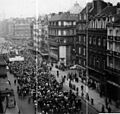History of Belgium facts for kids
The history of Belgium is a long story that started long before the country we know today was formed in 1830. It's closely connected to the histories of its neighbors: the Netherlands, Germany, France, and Luxembourg. For most of its past, the area that is now Belgium was either part of a bigger empire, like the Carolingian Empire, or split into many smaller states. Important states included the Duchy of Brabant, the County of Flanders, and the Prince-Bishopric of Liège.
Because of its location, Belgium has been called the "crossroads of Europe." Many armies fought on its land, earning it the nickname "battlefield of Europe." The country is divided by a language boundary between French (from Latin) and Dutch (Germanic).
Belgium's modern shape began with the southern part of the medieval Burgundian Netherlands. These lands were once split between France and Germany. But they were brought together by the House of Valois-Burgundy and later unified by Charles V, Holy Roman Emperor in 1549. The Eighty Years' War (1568–1648) then led to a split. The northern part became the Dutch Republic, while the southern part became the Southern Netherlands, from which Belgium and Luxembourg grew. This southern area was ruled by the Habsburg family, first as the Spanish Netherlands. Later, invasions by France under Louis XIV caused Belgium to lose some land, which is now part of France.
The area, which was a strong Habsburg territory for a long time, was briefly controlled by the Bourbon family during the War of the Spanish Succession. The Peace of Utrecht treaty gave the area back to the Habsburgs, creating the Austrian Netherlands. During the French Revolutionary wars, Belgium became part of France in 1795. This ended the semi-independence of areas that belonged to the Catholic church. After France's defeat in 1814, the Congress of Vienna created two new states: the United Kingdom of the Netherlands and the Grand Duchy of Luxembourg. Both were ruled by the House of Orange-Nassau.
The Southern Netherlands rebelled in 1830 during the Belgian Revolution. This led to the creation of the modern Belgian state, which was officially recognized at the London Conference of 1830. Leopold I became the first King of Belgium in 1831. He was known for quickly ending the Belgian part of the Revolutions of 1848. He also helped keep peace in Europe and maintained Belgium's neutrality.
Belgium's second king, Leopold II, created a colony in central Africa called the Congo Free State. This was his own personal territory. When terrible things happening under his rule became public, the Belgian government took control, creating the Belgian Congo. Belgium also saw the rise of liberal ideas, with the growth of the labour movement and the start of universal male suffrage (all men being able to vote).
The first half of the 20th century was very difficult. Belgium's neutrality was broken twice during the World Wars. Germany used Belgium's open land to get around French defenses. Belgian resistance in World War I angered the Germans, leading to the "Rape of Belgium" (widespread atrocities). In World War II, Leopold III of Belgium quickly surrendered to German forces in 1940. This caused a rift between the King and his people. After the war, he stayed in exile, and his brother, Prince Charles, Count of Flanders, ruled instead. Leopold's attempt to return in 1950 led to a constitutional crisis, and he gave up his throne to his son, Baudouin.
In the second half of the 20th century, Belgium experienced great economic growth. Belgium helped form the Benelux customs union with the Netherlands and Luxembourg. This union helped the countries resist American influence and plan their own economic future. Benelux later became a model for the European Economic Community, which was a step towards the European Union. Today, Brussels is home to many European Union institutions. Other big events during King Baudouin's rule included the independence of the Belgian Congo, which led to the Congo Crisis. There were also conflicts over school funding and the growth of the Flemish Movement.
Inside Belgium, there have been disagreements over language differences and unequal economic development. These ongoing issues have led to major changes since the 1970s. Belgium changed from a single state to a federal state, and there have been many government crises. It is now divided into three regions: Flanders (Dutch-speaking) in the north, Wallonia (French-speaking) in the south, and bilingual Brussels in the middle.
Since the 1990s, Belgium has been involved in several international conflicts. These were usually as part of United Nations peacekeeping missions, including in the Rwandan Civil War, Somalia, and the Kosovo War. Environmental worries became a big issue with the Dioxin affair, which caused the government of Jean-Luc Dehaene to fall. Since then, Belgian politics has become more divided. The 2010 Belgian federal election was famous because it took almost a year to form a government. In recent elections, a growing right-wing Flemish nationalist movement has had a strong impact on Belgian politics.
Contents
- Early History: From Stone Age to Romans
- Middle Ages: Kingdoms and City Power
- Burgundian and Habsburg Rule (15th-18th Centuries)
- United Kingdom of the Netherlands (1815-1830)
- The Belgian Revolution and Independence (1830)
- Industrial Growth and Social Changes (1830-1914)
- Belgian Empire: The Congo (Late 19th - Mid 20th Century)
- World War I (1914-1918)
- Between the World Wars (1918-1939)
- World War II (1939-1945)
- Post-War Belgium (1945-Present)
- Images for kids
- See also
Early History: From Stone Age to Romans
Humans have lived in Belgium for a very long time. Neanderthal fossils, some over 100,000 years old, were found in places like Engis in 1829. The first farming technology in northern Europe, called the "Linear Pottery culture," reached eastern Belgium around 5000 BC. These early farmers built defensive walls around their villages.
Later, other farming cultures appeared, but farming didn't always last. Hunter-gatherers stayed in the sandy north of Belgium. Over time, the population grew, especially from around 1750 BC during the late Bronze Age. Different European cultures arrived, bringing new ways of life.
Around 500 BC, Celtic tribes settled in the region and traded with the Mediterranean world. The first coins were used around 150 BC, influenced by this trade.
Roman Times and the Belgae
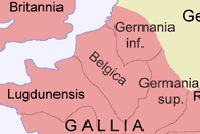
When Julius Caesar arrived in the region, he wrote about the people living in Belgium, northern France, and the German Rhineland. He called them the Belgae, and modern Belgium is named after them. They were considered the northern part of Gaul. Caesar said the Belgae were different from the rest of Gaul in language, law, and customs. He also mentioned they had Germanic ancestors.
The Romans created provinces, and the area of modern Belgium became part of the Roman province of Gallia Belgica. Important Roman cities in this area included Tongeren and later Tournai. Christianity also came to Belgium during the late Roman period. Saint Servatius was one of the first known bishops in the region, teaching in Tongeren in the 4th century.
Middle Ages: Kingdoms and City Power
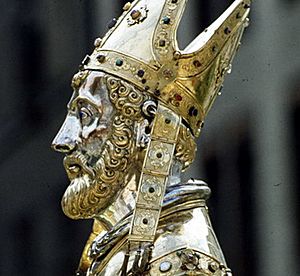
As the Western Roman Empire weakened, Germanic tribes took over and formed kingdoms. The Franks, a Germanic tribe, became very powerful. The famous Frankish king Clovis I conquered northern France and then the lands that included Belgium. He became Catholic, and many followed him. Christian missionaries helped spread the new religion.
The Carolingian dynasty followed the Merovingians. Their power base was in and around eastern Belgium. King Charlemagne, born near Liège, ruled a huge part of Europe and was crowned "Emperor of the new Holy Roman Empire" in 800 AD.
The Frankish lands were divided, and the parts of Belgium became part of the Holy Roman Empire. In the early Middle Ages, northern Belgium (now Flanders) spoke Germanic languages, while the south (now Wallonia) remained Romanized and spoke Latin-based languages. This is how the modern language boundary in Belgium began.
As emperors and kings lost control, the area of Belgium split into independent feudal states, such as:
Flanders, especially the coastal area, became very wealthy in the late Middle Ages due to trade with England, France, and Germany. Cities like Ypres, Bruges, and Ghent became important centers for trade, industry (especially textiles), and art. Many Gothic cathedrals and city halls were built during this time.
In 1302, Flemish forces famously defeated French knights at the Battle of the Golden Spurs. This showed the strength of the Flemish cities and their desire for independence from French control.
Burgundian and Habsburg Rule (15th-18th Centuries)
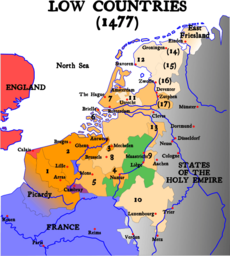
By 1433, most of Belgium and Luxembourg became part of Burgundy under Philip the Good. When Mary of Burgundy married Maximilian I, Holy Roman Emperor, these lands became part of the Habsburg family's territory. Their grandson, Charles V, Holy Roman Emperor, inherited many lands, uniting the Holy Roman Empire with Spain.
During the Burgundian period (15th and 16th centuries), cities like Tournai, Bruges, Ghent, Brussels, and Antwerp became major European centers for business, industry, and art. Bruges was a pioneer in trade and banking. Antwerp later became a huge port, especially for spices. This era also saw the rise of famous painters like Jan van Eyck and Rogier van der Weyden, known as the "Flemish Primitives."
In 1549, Charles V created the Seventeen Provinces, also called Belgica Regia. This area, which included all of modern Belgium, Luxembourg, and the Netherlands, became a single entity, separate from the Empire and France. In 1555, Charles V gave these lands to his son, Philip II.
The Dutch Revolt and Spanish Rule
The northern part of the Seventeen Provinces became mostly Protestant, while the southern part (modern Belgium) remained mostly Catholic. Philip II tried to stop Protestantism, leading to the Eighty Years' War (1568–1648) between Spain and the Dutch Republic. This war was very brutal, with massacres and religious violence.
Spanish forces, led by commanders like Fernando Álvarez de Toledo, 3rd Duke of Alba, tried to regain control. The Duke of Alba set up a special court called the "Council of Blood," which condemned many people to death. The war caused a deep split. The seven northern provinces formed the Union of Utrecht to fight Spain and gain independence. The southern provinces, by the Union of Atrecht in 1579, stayed loyal to the Spanish king.
In 1585, the Spanish captured Antwerp, a very rich city. Many people from Antwerp and other southern cities fled north to the newly independent Dutch Republic. While the northern part of the Seventeen Provinces gained independence, the southern part (the Southern Netherlands) remained under Spanish rule until 1713.
French Wars and Austrian Rule
In the 17th century, Antwerp remained important for industry and art, even though the Dutch blocked its port. Famous Baroque painters like Peter Paul Rubens and Van Dyck worked during this time.
France, under Louis XIV, often tried to expand its territory, especially into the Southern Netherlands. This led to many wars, including the War of Devolution and the Nine Years' War. Much of the fighting happened on Belgian soil.
After the War of the Spanish Succession, the Belgian and Luxembourg territories were given to the Austrian Habsburgs in 1714. This created the Austrian Netherlands (1714–1797).
The Brabant Revolution and French Control
In 1789, the "First Belgian Revolution," also known as the Brabant Revolution, started. People wanted independence from Austrian rule. Rebels defeated the Austrians and formed the United States of Belgium. However, the new state was divided, and the revolt was crushed by November 1790.
Soon after, during the French Revolutionary Wars, France invaded and took over Belgium in 1795. This ended Habsburg rule. Belgium became an official part of France. The French brought many new reforms, like equal legal rights and the end of class distinctions. However, French rule was unpopular. Belgians were forced to join the French army and pay high taxes. The Catholic Church was also repressed. This strong resistance helped create a sense of Belgian nationalism.
The French occupation also led to the suppression of the Dutch language. French became the only accepted language in public life. In 1798, a massive draft into the French army sparked the "Peasants' War," especially in Flemish regions. This brutal suppression is seen as the start of the modern Flemish movement.
In 1814, Napoleon was defeated, and French rule ended.
United Kingdom of the Netherlands (1815-1830)
After Napoleon's defeat at Waterloo in 1815, European powers decided at the Congress of Vienna to unite the former Austrian Netherlands (Belgium) and the former Dutch Republic. This created the United Kingdom of the Netherlands, meant to be a strong state against future French invasions. It was ruled by a Protestant king, William I.
King William I tried to modernize the country and promote industry. However, there was growing unhappiness in the southern provinces (Belgium). Protestants, who were a minority, controlled the new country. The Catholic majority in the south felt their voice wasn't heard. The king also tried to make Dutch the official language, which angered the French-speaking Walloons. Political liberals in the south disliked the king's authoritarian style. All groups in the south felt they were unfairly represented in the government.
The south was industrializing faster and was more prosperous than the north. This led to resentment of northern dominance. When a revolution broke out in France in 1830, it sparked a revolt in Belgium. At first, people wanted more self-rule, but soon they demanded full independence.
The Belgian Revolution and Independence (1830)
The Belgian Revolution began in August 1830 in Brussels. Crowds, inspired by a patriotic opera, took to the streets. Violent street fighting broke out. The revolution happened for many reasons: Belgians felt under-represented, disliked King William I's representative, and were inspired by the French Revolution. French-speaking Walloons felt left out in a Dutch-speaking country, and the Catholic majority resented being ruled by Dutch Protestants.
The king sent in the army, but they met strong resistance from revolutionaries. After three days of fighting, Dutch troops left Brussels. Battles also occurred around the country. In Antwerp, Dutch warships bombarded the city after revolutionaries captured it.
Even though the 1815 Congress of Vienna didn't allow Belgian independence, the major European powers, especially Britain and France, supported the revolutionaries. In November 1830, the London Conference of 1830 ordered a ceasefire. Britain and France proposed an independent kingdom of Belgium, which was accepted. The new kingdom had to remain neutral in foreign affairs.
Leopold I of Saxe-Coburg was chosen as the first "King of the Belgians." He was inaugurated on July 21, 1831, which is now Belgium's national holiday. The Belgian National Congress created a new constitution, making Belgium a sovereign, independent state with a constitutional monarchy. However, voting rights were limited to the wealthy French-speaking middle class and clergy.
The conflict with the Netherlands lasted eight more years. In 1839, the Treaty of London (1839) was signed. Belgium lost its eastern part of Luxembourg (which remained with the Netherlands until it became an independent Grand Duchy) and parts of Limburg and Zeeland. The five great powers promised to protect Belgium's neutrality. This promise was important in 1914 when Germany's violation of Belgium's neutrality led Britain to enter World War I.
Industrial Growth and Social Changes (1830-1914)
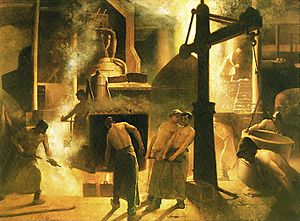
Belgium became the second country, after Britain, to have an Industrial Revolution. It quickly developed an economy focused on industrial exports. This was especially true in Wallonia (French-speaking southern Belgium), starting in the 1820s. The availability of cheap coal was a key factor. Factories for steel and other metals were built around Liège and Charleroi. John Cockerill, an Englishman, led the way with his integrated factories at Seraing.
The textile industry, using cotton and flax, employed many workers. Ghent was a major industrial city until the 1880s, when Liège and its steel industry grew. Wallonia had rich coalfields, and mines went deeper and deeper thanks to steam pumps. Belgium became a leader in coal mining, but gas explosions were a serious problem.
Railways and Industry
Belgium quickly built a railway system connecting major cities, ports, and mining areas. This made Belgium a railway hub in the region. The first railway in continental Europe was built in Belgium in 1835, between Brussels and Mechelen. By the 1900s, Belgium was a major exporter of trams and other rail parts. Belgian companies built public transport systems around the world, including the Paris Métro.
Other important Belgian businesses included Cockerill-Sambre (steel), the chemical factories of Ernest Solvay, and the firearms maker Fabrique Nationale de Herstal.
Politics: Catholics, Liberals, and Language
Belgian politics was mainly a struggle between the Catholic Party and the Liberal Party. Catholics were generally more religious, conservative, and rural. Liberals were more secular, progressive, and urban. The "First School War" (1879–1884) was a big conflict when Liberals tried to make primary education less religious, but Catholics fought back. This led to a long period of Catholic Party dominance.
The country also faced a growing language conflict. French was the official language after 1830, and French culture dominated. Dutch, spoken by the majority in the north, was seen as a "second-class culture." The Flemish Movement grew, pushing for Dutch to have equal status with French, especially in schools and courts. This was achieved through laws in the 1920s and 1930s. Dutch became the language of government and education in the northern provinces. Brussels became officially bilingual.
Rise of Socialists and Voting Rights
The economy faced problems in the late 19th century, leading to labor unrest. The Belgian Labour Party was founded in 1885, calling for an end to capitalism. They used general strikes to pressure the government. The 1893 General Strike helped achieve universal male suffrage, though voting power was still unequal based on wealth and education.
Later strikes in 1902 and 1913 aimed to end this unequal voting system. After World War I, King Albert I helped bring about "one man, one vote" for all men in 1918. Women gained full voting rights in 1948.
Belgian Empire: The Congo (Late 19th - Mid 20th Century)
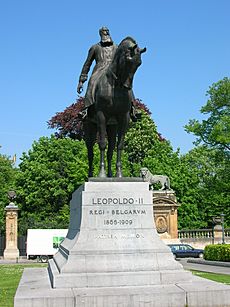
King Leopold II of Belgium personally acquired a vast territory in Africa, which he named the Congo Free State (1885–1908). This area was almost 80 times the size of Belgium. It was meant to be a free trade zone, but Leopold used it to make a huge personal fortune, mainly from selling rubber.
The Congo Free State became infamous for terrible atrocities. To meet rubber quotas, the Force Publique, a military force, was created. If villages didn't meet their quotas, soldiers would use harsh methods like abduction, forced labor, and executions. Millions of Congolese people died from exploitation and disease during this period.
Reports from missionaries led to international outrage, especially in Britain and the United States. The Congo Reform Association campaigned against the abuses. In 1908, the Belgian parliament took control of the Free State, turning it into the Belgian Congo.
After World War II, Belgium was criticized for not preparing the Congo for independence. Few Belgians were interested in the colony, and the government limited Congolese people from settling in Belgium. Political rights were only granted to Africans in 1956. In 1960, after riots, the Belgian Congo gained independence, leading to the Congo Crisis.
World War I (1914-1918)
When World War I started, Germany invaded neutral Belgium and Luxembourg as part of its plan to quickly attack France. This invasion caused Britain to enter the war, using the 1839 agreement to protect Belgium's neutrality as a reason.
The Belgian army bravely resisted the German invasion in 1914. They held up the German advance for nearly a month, giving French and British forces time to prepare. The Germans treated any resistance as illegal, executing civilians and burning buildings in retaliation. This period is known as the "Rape of Belgium."
King Albert I stayed in Belgium to lead the army, while the government moved to France. Belgian units continued fighting until 1918. Forces from the Belgian Congo also played a role in the African campaign.
German Occupation
Most of Belgium was under German military rule from 1914 to 1918. The Germans "stripped the country bare," taking machinery and factory parts. Many Belgians became unemployed. Over 1.4 million refugees fled to France or the neutral Netherlands.
There was no violent resistance movement, but many Belgians passively resisted by refusing to work for the Germans. The Germans also tried to use the Flamenpolitik (Flemish policy) to gain support from the Flemish population by promoting the Dutch language. This led to a stronger Flemish movement after the war.
Belgium faced a severe food crisis during the occupation. An American engineer, Herbert Hoover, organized an international effort called the Commission for Relief in Belgium (CRB) to feed the entire nation.
Between the World Wars (1918-1939)
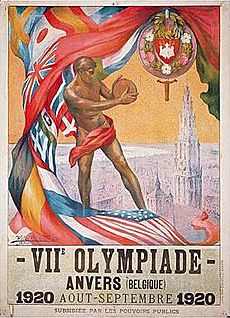
After World War I, King Albert returned as a hero. Belgium had been devastated, but it recovered surprisingly quickly. The first postwar Olympic Games were held in Antwerp in 1920. In 1921, Luxembourg formed a customs union with Belgium.
Under the Treaty of Versailles in 1919, the areas of Eupen-Malmedy and Moresnet were transferred to Belgium from Germany.
Between 1923 and 1926, Belgian and French soldiers occupied the Ruhr region in Germany to force Germany to pay war reparations.
Belgian Surrealist art grew during this period, with famous artists like René Magritte and Paul Delvaux. Comic strips also became very popular, with Hergé's The Adventures of Tintin first appearing in 1929.
World War II (1939-1945)
Belgium tried to remain neutral before World War II, but on May 10, 1940, Germany invaded. Belgian defenses were quickly overcome. On May 28, after 18 days of fighting, Belgian forces, including King Leopold III, surrendered. The elected Belgian government escaped to the United Kingdom to form a government in exile.
Belgian Forces Abroad
Many Belgian soldiers and civilians escaped to Britain to join the Belgian army in exile. The 1st Belgian Infantry Brigade, also known as the Brigade Piron, fought in the Normandy Invasion and battles in France and the Netherlands. Belgians also served in British special forces and the Royal Air Force.
The Belgian Congo made a significant contribution. Congolese soldiers of the Force Publique fought against Italian forces in Africa. The Congo was also vital for its exports of rubber and uranium. The uranium used for the atomic bombs dropped on Hiroshima and Nagasaki came from the Belgian Congo.
German Occupation and Resistance
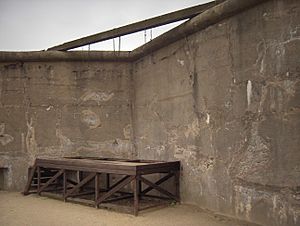
Belgium was under German military government from 1940 to 1944. The former fort at Breendonk was used by the Nazis to detain and interrogate Jews, political prisoners, and resistance members. Thousands died there.
Nearly 70,000 Jews lived in Belgium in 1940. Many were deported to death camps like Auschwitz. Over 25,000 Jews were transported from Belgium, and only a small number survived.
Resistance against the German occupiers was widespread but fragmented. Groups like the Armée Secrète helped Allied airmen escape and carried out sabotage. The resistance also helped save Jews and Roma from deportation. Many Belgians hid Jews and political dissidents.
Collaboration
Some Belgians collaborated with the Nazis. Pro-Nazi political groups existed in both Flemish and Walloon communities, like DeVlag and the Rexist movement. These groups encouraged Belgians to join the German army. Two divisions of the Waffen SS were made up of Flemish and Walloon volunteers. After the war, many collaborators were tried and punished.
Liberation
Belgium was liberated in late 1944 by Allied forces, including British, Canadian, and American armies. On September 3, 1944, British forces liberated Brussels. The British Second Army captured Antwerp on September 4, 1944. Antwerp's port was crucial for supplying the Allied armies. The Battle of the Bulge in the winter of 1944–45 involved heavy fighting on Belgian soil. By the end of the war, 100,000 Belgians had been mobilized for the Allies.
Post-War Belgium (1945-Present)
The "Royal Question"
Immediately after the war, Léopold III was released from German captivity. However, there was a big debate about whether he had betrayed his country by surrendering in 1940. Many Belgians, especially Socialists, opposed his return to power. He stayed in exile in Switzerland until 1950.
A referendum in 1950 showed a split: Flanders voted for his return, but Wallonia and Brussels voted against it. Although the overall vote was in his favor, strong protests and a General Strike broke out. To avoid further conflict, Léopold III gave up his throne on July 16, 1951, in favor of his 20-year-old son, Baudouin.
Economic Growth and European Integration
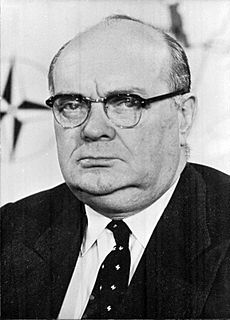
After World War II, Belgium experienced a period of great economic growth, sometimes called the "Belgian miracle." The American Marshall Plan provided significant aid to help rebuild Europe. Belgium's economy grew, and living standards improved.
Belgium played a key role in forming European organizations. The Benelux Customs Union was created in 1944, later becoming the Benelux Economic Union. Belgium was also a founding member of NATO in 1949. NATO's headquarters are in Brussels. Belgium was also one of the original members of the European Coal and Steel Community (ECSC) in 1952 and the European Economic Community (EEC) in 1957. These were early steps towards the European Union. Belgium has been part of the Schengen area since 1985, allowing free movement across borders.
Congo Independence and Crisis
After riots in the Congo in 1959, the transition to independence was sped up. In June 1960, the Belgian Congo became the First Republic of Congo. However, order quickly broke down, and a civil war known as the Congo Crisis began. The southern state of Katanga Province declared independence, supported by Belgian mining companies. Belgian paratroopers were sent in to rescue civilians. Eventually, Joseph Mobutu took power, unifying the country as Zaire.
Linguistic Conflicts and Federalism
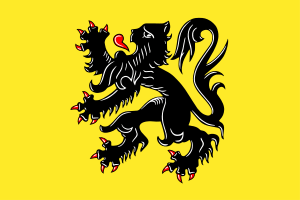
The Flemish population, which is the majority, gained more political power. The "linguistic wars" reached a peak in 1968 when the Catholic University of Leuven was split into separate Dutch and French-speaking universities.
These language disputes made Belgian governments unstable. The major political parties split into separate French-speaking and Dutch-speaking parties. In 1962 and 1963, laws were passed to define language areas in Belgium: Dutch, French, German, and bilingual Brussels.
In 1970, Belgium began a series of "state reforms" to become a federal state. This meant giving more power to different regions and communities.
- 1970: Three cultural communities were created: Dutch, French, and German.
- 1980: These cultural communities became "Communities" and gained more responsibilities, like health and youth policy. Two regions were also created: the Flemish Region and the Walloon Region.
- 1988-1989: The Brussels-Capital Region was established with its own institutions. Education was transferred to the Communities.
- 1993: Belgium officially became a federal state. The parliaments of the Communities and Regions became directly elected. The Province of Brabant was split into Flemish Brabant and Walloon Brabant.
- 2001: More powers were transferred to the Communities and Regions, including agriculture and foreign trade.
- 2011: The sixth state reform brought major changes, giving even more powers to the Communities and Regions.
Between 1999 and 2002, the Euro gradually replaced the Belgian franc as Belgium's currency.
Recent Politics and International Role
In the 1999 Belgian federal election, traditional parties lost support due to the "Dioxin Affair" (a food contamination scandal). A new government was formed without the Christian People's Party for the first time in decades.
Belgium strongly opposed the Iraq War in 2003, arguing that military action needed UN approval. In 2003, Belgium became the second country in the world to legally recognize same-sex marriage.
The 2010 Belgian federal election resulted in a very divided political scene. It took a record-breaking 353 days to form a new government. Finally, Elio Di Rupo became Prime Minister in 2011.
In recent years, the Vlaams Belang party (far-right Flemish nationalist) has gained support in Flanders. In 2019, Charles Michel became President of the European Council, and Sophie Wilmès became Belgium's first female prime minister. In 2020, Alexander De Croo became the new prime minister.
Belgium has also been involved in several international conflicts as part of UN peacekeeping missions. This includes missions in Rwanda (where 10 Belgian peacekeepers were murdered in 1994), Somalia, and Kosovo. Belgian soldiers have also served in Lebanon and Afghanistan. The Belgian Air Force participated in the 2011 military intervention in Libya.
Images for kids
-
The Battle of Nieuwpoort (1600).
See also
 In Spanish: Historia de Bélgica para niños
In Spanish: Historia de Bélgica para niños


